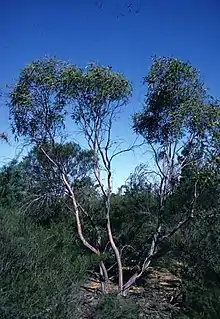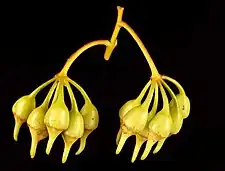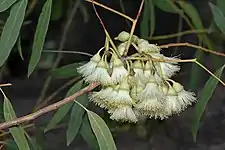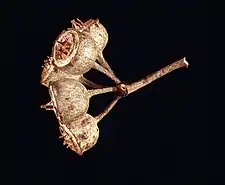| Beard's mallee | |
|---|---|
 | |
| Eucalyptus beardiana growing in the North Murchison | |
| Scientific classification | |
| Kingdom: | Plantae |
| Clade: | Tracheophytes |
| Clade: | Angiosperms |
| Clade: | Eudicots |
| Clade: | Rosids |
| Order: | Myrtales |
| Family: | Myrtaceae |
| Genus: | Eucalyptus |
| Species: | E. beardiana |
| Binomial name | |
| Eucalyptus beardiana | |
Eucalyptus beardiana, commonly known as Beard's mallee,[3] is a mallee that is endemic to Western Australia. It has smooth pinkish bark, narrow lance-shaped to curved adult leaves, flower buds usually in groups of nine, pale yellow flowers and down-turned, hemispherical fruit.



Description
Eucalyptus beardiana is a spreading mallee that typically grows to a height of 3 to 5 metres (10 to 16 ft) and forms a lignotuber. It has smooth grey, cream-cloloured or pinkish bark from the trunk to the thinnest branches. Young plants and coppice regrowth have dull, narrow lance-shaped leaves 20–90 mm (0.79–3.5 in) long and 5–35 mm (0.2–1 in) wide and have a petiole. Adult leaves are lance-shaped to curved, mostly 75–130 mm (3.0–5.1 in) long and 7–15 mm (0.3–0.6 in) wide, narrowing at the base to a petiole 10–23 mm (0.39–0.91 in) long.[4][5][6]
The flowers are usually borne in groups of nine, rarely eleven, in leaf axils on an unbranched peduncle 20–30 mm (0.8–1 in) long, the individual flowers on a pedicel 12–14 mm (0.5–0.6 in) long. Mature buds are oval, 19–22 mm (0.7–0.9 in) long and 7–9 mm (0.3–0.4 in) wide with a finely beaked operculum about 14 mm (0.6 in) long. Flowering mainly occurs from August to September and the flowers are pale yellow to creamy white. The fruit that follows is a woody, hemispherical capsule 7 to 10 mm (0.28 to 0.39 in) long and 9 to 13 mm (0.35 to 0.51 in) with a slightly flared rim.[4][5][6][3]
Taxonomy and naming
Eucalyptus beardiana was first formally described in 1978 by Ian Brooker and Donald Blaxell who published the description in the journal Nuytsia from a specimen collected near Shark Bay.[7] The specific epithet (beardiana) honours John Stanley Beard. The authors considered it appropriate that "his long association with the botany of Western Australia should be perpetuated by a species endemic to the state".[6]
Distribution and habitat
Beard's mallee grows in tree heath, tall open shrubland in association with species including Yuna mallee, mallalie, Eucalyptus gittinsii, sceptre banksia, Ashby's banksia, broom honey-myrtle as well as other species of Acacia, Grevillea and Persoonia. It is found on sandplain between the Murchison River and Shark Bay.[3][8]
Conservation
Eucalyptus beardiana is classified as "endangered" under the Australian Government Environment Protection and Biodiversity Conservation Act 1999 and as "Threatened Flora (Declared Rare Flora — Extant)" by the Department of Environment and Conservation (Western Australia).[3] The main threat to the species is habitat disturbance due to firebreak and track maintenance and by grazing animals and weed invasion.[8]
See also
References
- ↑ Fensham, R.; Collingwood, T.; Laffineur, B. (2019). "Eucalyptus beardiana". IUCN Red List of Threatened Species. 2019: e.T133374847A133374849. doi:10.2305/IUCN.UK.2019-3.RLTS.T133374847A133374849.en. Retrieved 20 September 2021.
- ↑ "Eucalyptus beardiana". Australian Plant Census. Retrieved 15 March 2019.
- 1 2 3 4 "Eucalyptus beardiana". FloraBase. Western Australian Government Department of Biodiversity, Conservation and Attractions.
- 1 2 "Eucalyptus beardiana". Euclid: Centre for Australian National Biodiversity Research. Retrieved 15 March 2019.
- 1 2 Chippendale, George M. "Eucalyptus beardiana". Australian Biological Resources Study, Department of the Environment and Energy, Canberra. Retrieved 15 March 2019.
- 1 2 3 Brooker, M. Ian (1978). "Blaxell". Donald F. 2 (4): 220–222. Retrieved 15 March 2019.
- ↑ "Eucalyptus beardiana". APNI. Retrieved 15 March 2019.
- 1 2 "Approved Conservation Advice for Eucalyptus beardiana (Beard's mallee)" (PDF). Australian Government Department of the Environment. Retrieved 15 March 2019.
